Business Administration Report: Tesco's Management and Strategy
VerifiedAdded on 2020/12/09
|13
|4386
|444
Report
AI Summary
This report provides a comprehensive analysis of business administration principles as applied within Tesco, a multinational retailer. The report delves into the importance of defining objectives, scope, and success criteria in decision-making, assessing the impact of these decisions and the necessity of obtaining and validating information. It examines the alignment of decisions with business objectives, values, and policies. Furthermore, it explores leadership styles, motivational theories, and their practical application in the workplace. The report also investigates management responsibilities, including planning, coordination, and control, along with the use of KPIs and performance measurement systems to achieve organizational vision and objectives. It provides a detailed overview of various management theories and their influence on managerial actions, as well as the significance of aligning business objectives with performance measures. Finally, it discusses the use of management accounts and information systems in performance management, differentiating between outcomes and outputs to provide a holistic understanding of Tesco's operational strategies.
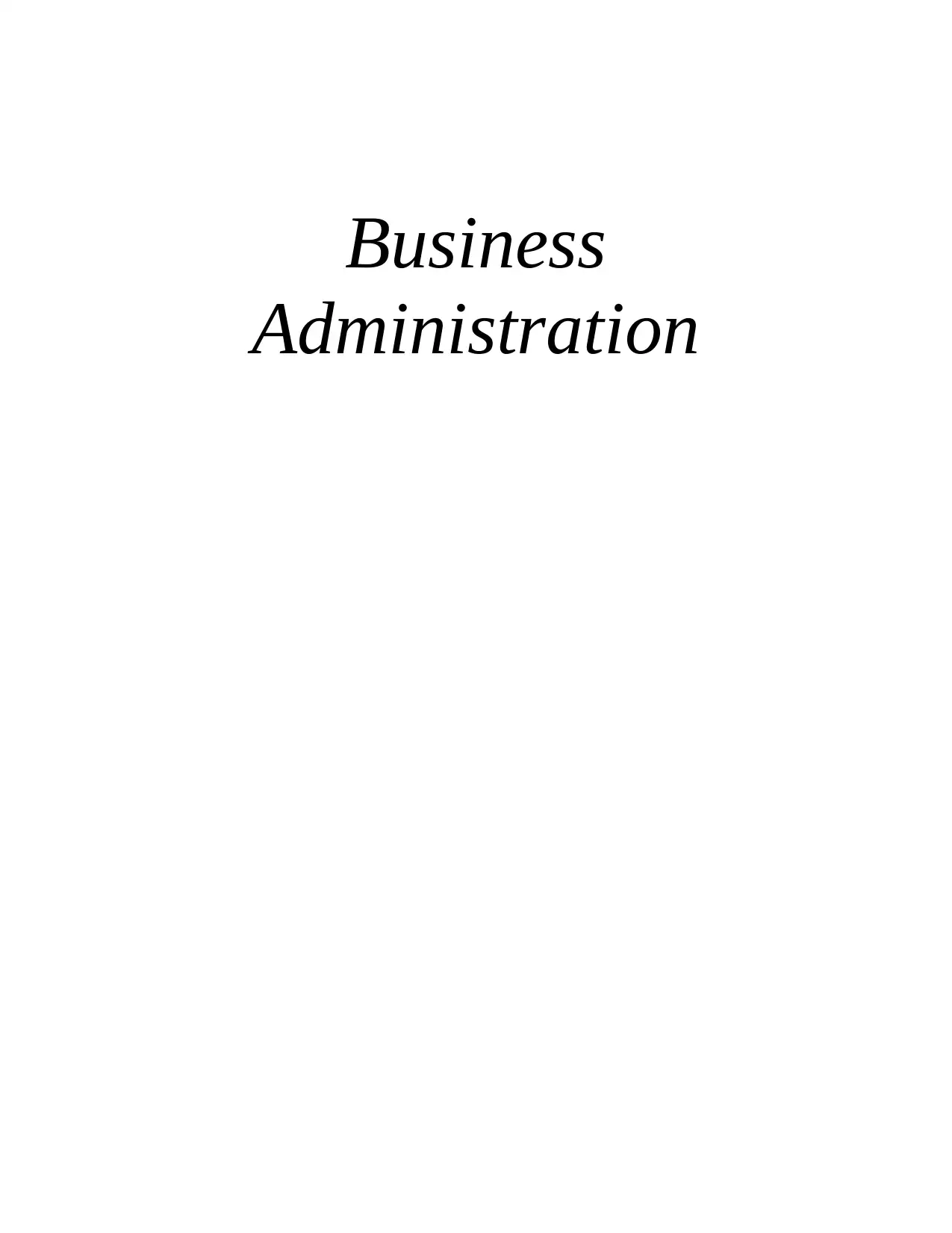
Business
Administration
Administration
Paraphrase This Document
Need a fresh take? Get an instant paraphrase of this document with our AI Paraphraser
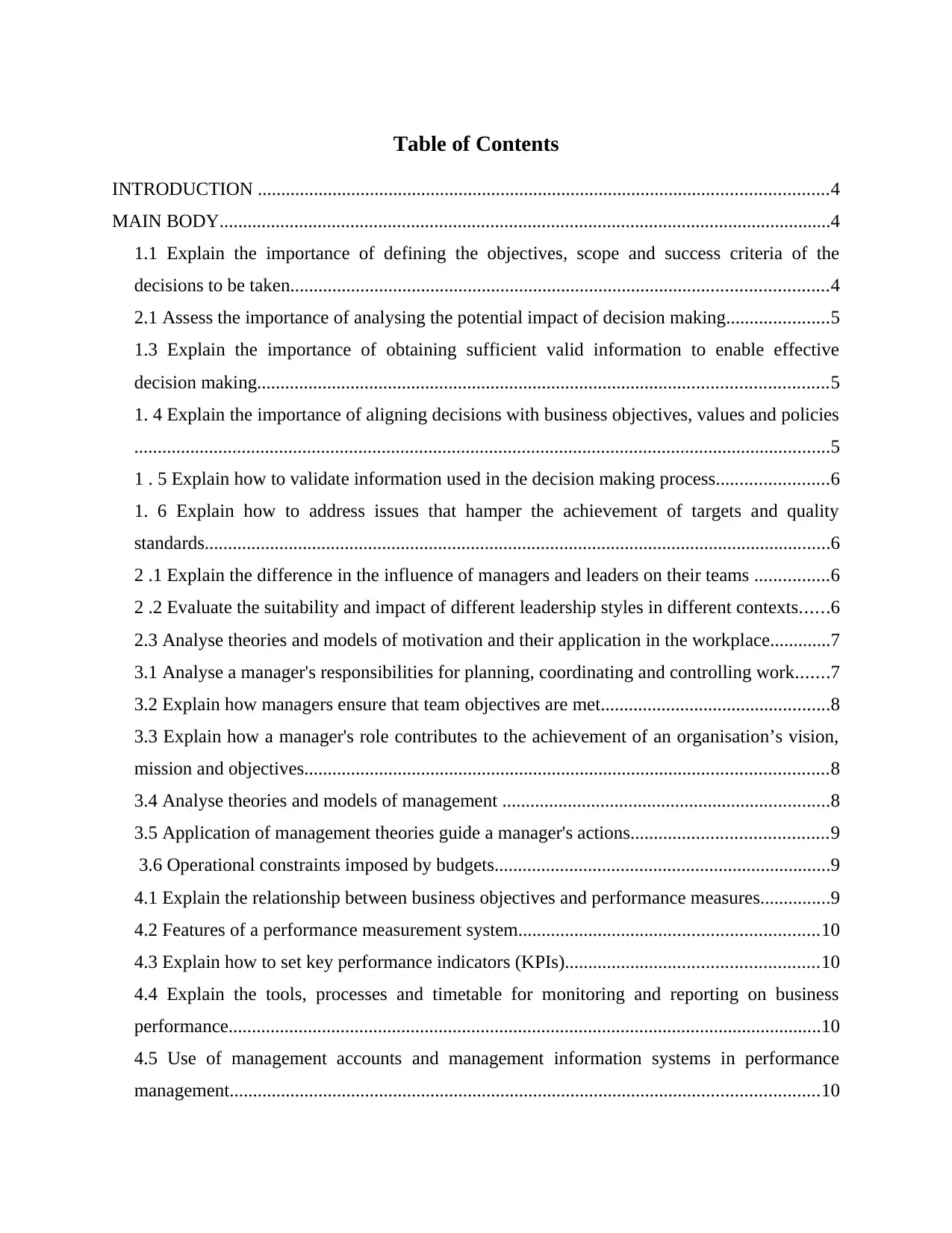
Table of Contents
INTRODUCTION ..........................................................................................................................4
MAIN BODY...................................................................................................................................4
1.1 Explain the importance of defining the objectives, scope and success criteria of the
decisions to be taken...................................................................................................................4
2.1 Assess the importance of analysing the potential impact of decision making......................5
1.3 Explain the importance of obtaining sufficient valid information to enable effective
decision making..........................................................................................................................5
1. 4 Explain the importance of aligning decisions with business objectives, values and policies
.....................................................................................................................................................5
1 . 5 Explain how to validate information used in the decision making process........................6
1. 6 Explain how to address issues that hamper the achievement of targets and quality
standards......................................................................................................................................6
2 .1 Explain the difference in the influence of managers and leaders on their teams ................6
2 .2 Evaluate the suitability and impact of different leadership styles in different contexts......6
2.3 Analyse theories and models of motivation and their application in the workplace.............7
3.1 Analyse a manager's responsibilities for planning, coordinating and controlling work.......7
3.2 Explain how managers ensure that team objectives are met.................................................8
3.3 Explain how a manager's role contributes to the achievement of an organisation’s vision,
mission and objectives................................................................................................................8
3.4 Analyse theories and models of management ......................................................................8
3.5 Application of management theories guide a manager's actions..........................................9
3.6 Operational constraints imposed by budgets........................................................................9
4.1 Explain the relationship between business objectives and performance measures...............9
4.2 Features of a performance measurement system................................................................10
4.3 Explain how to set key performance indicators (KPIs)......................................................10
4.4 Explain the tools, processes and timetable for monitoring and reporting on business
performance...............................................................................................................................10
4.5 Use of management accounts and management information systems in performance
management..............................................................................................................................10
INTRODUCTION ..........................................................................................................................4
MAIN BODY...................................................................................................................................4
1.1 Explain the importance of defining the objectives, scope and success criteria of the
decisions to be taken...................................................................................................................4
2.1 Assess the importance of analysing the potential impact of decision making......................5
1.3 Explain the importance of obtaining sufficient valid information to enable effective
decision making..........................................................................................................................5
1. 4 Explain the importance of aligning decisions with business objectives, values and policies
.....................................................................................................................................................5
1 . 5 Explain how to validate information used in the decision making process........................6
1. 6 Explain how to address issues that hamper the achievement of targets and quality
standards......................................................................................................................................6
2 .1 Explain the difference in the influence of managers and leaders on their teams ................6
2 .2 Evaluate the suitability and impact of different leadership styles in different contexts......6
2.3 Analyse theories and models of motivation and their application in the workplace.............7
3.1 Analyse a manager's responsibilities for planning, coordinating and controlling work.......7
3.2 Explain how managers ensure that team objectives are met.................................................8
3.3 Explain how a manager's role contributes to the achievement of an organisation’s vision,
mission and objectives................................................................................................................8
3.4 Analyse theories and models of management ......................................................................8
3.5 Application of management theories guide a manager's actions..........................................9
3.6 Operational constraints imposed by budgets........................................................................9
4.1 Explain the relationship between business objectives and performance measures...............9
4.2 Features of a performance measurement system................................................................10
4.3 Explain how to set key performance indicators (KPIs)......................................................10
4.4 Explain the tools, processes and timetable for monitoring and reporting on business
performance...............................................................................................................................10
4.5 Use of management accounts and management information systems in performance
management..............................................................................................................................10

4.6 Explain the distinction between outcomes and outputs.....................................................11
CONCLUSION .............................................................................................................................11
REFERENCES..............................................................................................................................12
CONCLUSION .............................................................................................................................11
REFERENCES..............................................................................................................................12
⊘ This is a preview!⊘
Do you want full access?
Subscribe today to unlock all pages.

Trusted by 1+ million students worldwide
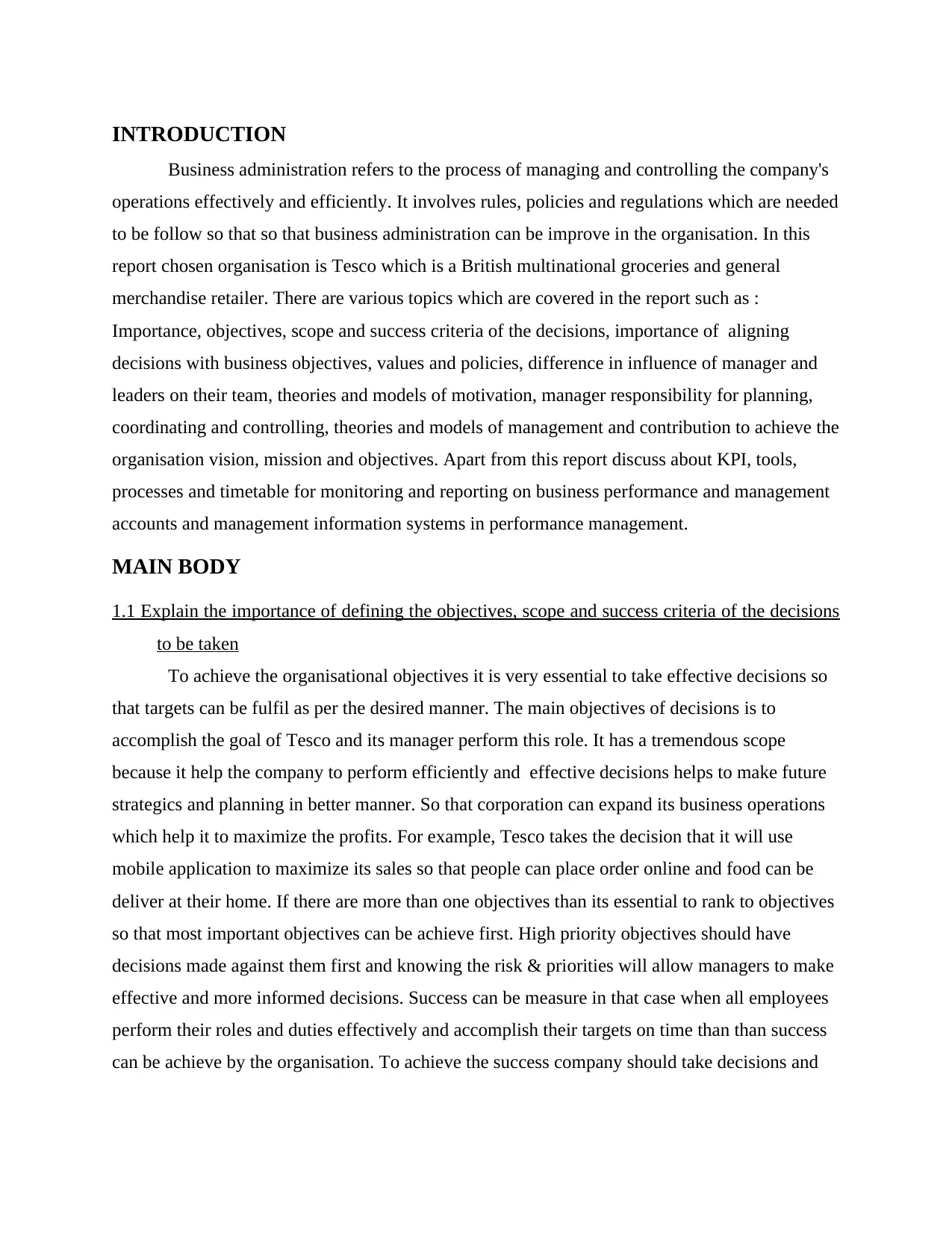
INTRODUCTION
Business administration refers to the process of managing and controlling the company's
operations effectively and efficiently. It involves rules, policies and regulations which are needed
to be follow so that so that business administration can be improve in the organisation. In this
report chosen organisation is Tesco which is a British multinational groceries and general
merchandise retailer. There are various topics which are covered in the report such as :
Importance, objectives, scope and success criteria of the decisions, importance of aligning
decisions with business objectives, values and policies, difference in influence of manager and
leaders on their team, theories and models of motivation, manager responsibility for planning,
coordinating and controlling, theories and models of management and contribution to achieve the
organisation vision, mission and objectives. Apart from this report discuss about KPI, tools,
processes and timetable for monitoring and reporting on business performance and management
accounts and management information systems in performance management.
MAIN BODY
1.1 Explain the importance of defining the objectives, scope and success criteria of the decisions
to be taken
To achieve the organisational objectives it is very essential to take effective decisions so
that targets can be fulfil as per the desired manner. The main objectives of decisions is to
accomplish the goal of Tesco and its manager perform this role. It has a tremendous scope
because it help the company to perform efficiently and effective decisions helps to make future
strategics and planning in better manner. So that corporation can expand its business operations
which help it to maximize the profits. For example, Tesco takes the decision that it will use
mobile application to maximize its sales so that people can place order online and food can be
deliver at their home. If there are more than one objectives than its essential to rank to objectives
so that most important objectives can be achieve first. High priority objectives should have
decisions made against them first and knowing the risk & priorities will allow managers to make
effective and more informed decisions. Success can be measure in that case when all employees
perform their roles and duties effectively and accomplish their targets on time than than success
can be achieve by the organisation. To achieve the success company should take decisions and
Business administration refers to the process of managing and controlling the company's
operations effectively and efficiently. It involves rules, policies and regulations which are needed
to be follow so that so that business administration can be improve in the organisation. In this
report chosen organisation is Tesco which is a British multinational groceries and general
merchandise retailer. There are various topics which are covered in the report such as :
Importance, objectives, scope and success criteria of the decisions, importance of aligning
decisions with business objectives, values and policies, difference in influence of manager and
leaders on their team, theories and models of motivation, manager responsibility for planning,
coordinating and controlling, theories and models of management and contribution to achieve the
organisation vision, mission and objectives. Apart from this report discuss about KPI, tools,
processes and timetable for monitoring and reporting on business performance and management
accounts and management information systems in performance management.
MAIN BODY
1.1 Explain the importance of defining the objectives, scope and success criteria of the decisions
to be taken
To achieve the organisational objectives it is very essential to take effective decisions so
that targets can be fulfil as per the desired manner. The main objectives of decisions is to
accomplish the goal of Tesco and its manager perform this role. It has a tremendous scope
because it help the company to perform efficiently and effective decisions helps to make future
strategics and planning in better manner. So that corporation can expand its business operations
which help it to maximize the profits. For example, Tesco takes the decision that it will use
mobile application to maximize its sales so that people can place order online and food can be
deliver at their home. If there are more than one objectives than its essential to rank to objectives
so that most important objectives can be achieve first. High priority objectives should have
decisions made against them first and knowing the risk & priorities will allow managers to make
effective and more informed decisions. Success can be measure in that case when all employees
perform their roles and duties effectively and accomplish their targets on time than than success
can be achieve by the organisation. To achieve the success company should take decisions and
Paraphrase This Document
Need a fresh take? Get an instant paraphrase of this document with our AI Paraphraser
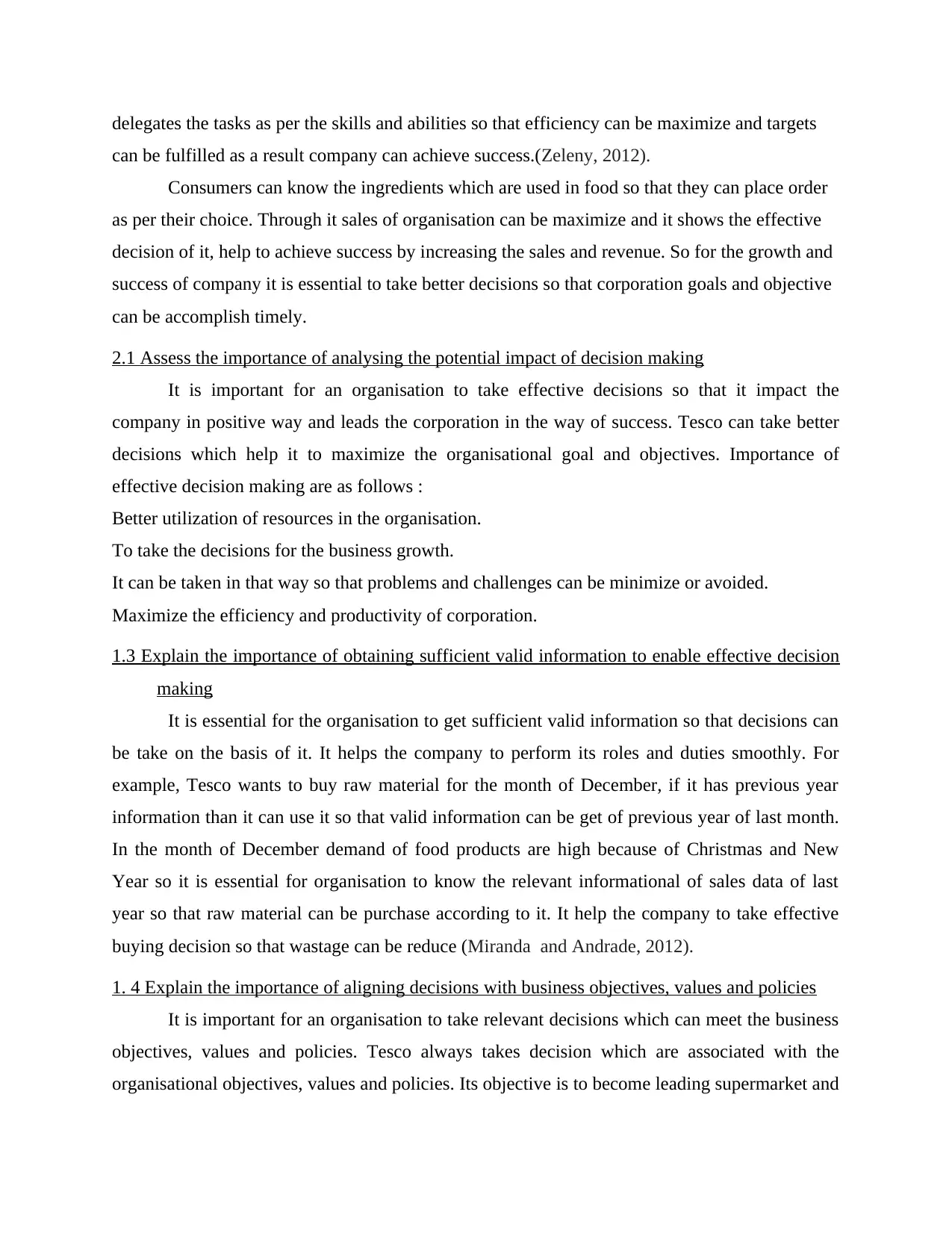
delegates the tasks as per the skills and abilities so that efficiency can be maximize and targets
can be fulfilled as a result company can achieve success.(Zeleny, 2012).
Consumers can know the ingredients which are used in food so that they can place order
as per their choice. Through it sales of organisation can be maximize and it shows the effective
decision of it, help to achieve success by increasing the sales and revenue. So for the growth and
success of company it is essential to take better decisions so that corporation goals and objective
can be accomplish timely.
2.1 Assess the importance of analysing the potential impact of decision making
It is important for an organisation to take effective decisions so that it impact the
company in positive way and leads the corporation in the way of success. Tesco can take better
decisions which help it to maximize the organisational goal and objectives. Importance of
effective decision making are as follows :
Better utilization of resources in the organisation.
To take the decisions for the business growth.
It can be taken in that way so that problems and challenges can be minimize or avoided.
Maximize the efficiency and productivity of corporation.
1.3 Explain the importance of obtaining sufficient valid information to enable effective decision
making
It is essential for the organisation to get sufficient valid information so that decisions can
be take on the basis of it. It helps the company to perform its roles and duties smoothly. For
example, Tesco wants to buy raw material for the month of December, if it has previous year
information than it can use it so that valid information can be get of previous year of last month.
In the month of December demand of food products are high because of Christmas and New
Year so it is essential for organisation to know the relevant informational of sales data of last
year so that raw material can be purchase according to it. It help the company to take effective
buying decision so that wastage can be reduce (Miranda and Andrade, 2012).
1. 4 Explain the importance of aligning decisions with business objectives, values and policies
It is important for an organisation to take relevant decisions which can meet the business
objectives, values and policies. Tesco always takes decision which are associated with the
organisational objectives, values and policies. Its objective is to become leading supermarket and
can be fulfilled as a result company can achieve success.(Zeleny, 2012).
Consumers can know the ingredients which are used in food so that they can place order
as per their choice. Through it sales of organisation can be maximize and it shows the effective
decision of it, help to achieve success by increasing the sales and revenue. So for the growth and
success of company it is essential to take better decisions so that corporation goals and objective
can be accomplish timely.
2.1 Assess the importance of analysing the potential impact of decision making
It is important for an organisation to take effective decisions so that it impact the
company in positive way and leads the corporation in the way of success. Tesco can take better
decisions which help it to maximize the organisational goal and objectives. Importance of
effective decision making are as follows :
Better utilization of resources in the organisation.
To take the decisions for the business growth.
It can be taken in that way so that problems and challenges can be minimize or avoided.
Maximize the efficiency and productivity of corporation.
1.3 Explain the importance of obtaining sufficient valid information to enable effective decision
making
It is essential for the organisation to get sufficient valid information so that decisions can
be take on the basis of it. It helps the company to perform its roles and duties smoothly. For
example, Tesco wants to buy raw material for the month of December, if it has previous year
information than it can use it so that valid information can be get of previous year of last month.
In the month of December demand of food products are high because of Christmas and New
Year so it is essential for organisation to know the relevant informational of sales data of last
year so that raw material can be purchase according to it. It help the company to take effective
buying decision so that wastage can be reduce (Miranda and Andrade, 2012).
1. 4 Explain the importance of aligning decisions with business objectives, values and policies
It is important for an organisation to take relevant decisions which can meet the business
objectives, values and policies. Tesco always takes decision which are associated with the
organisational objectives, values and policies. Its objective is to become leading supermarket and
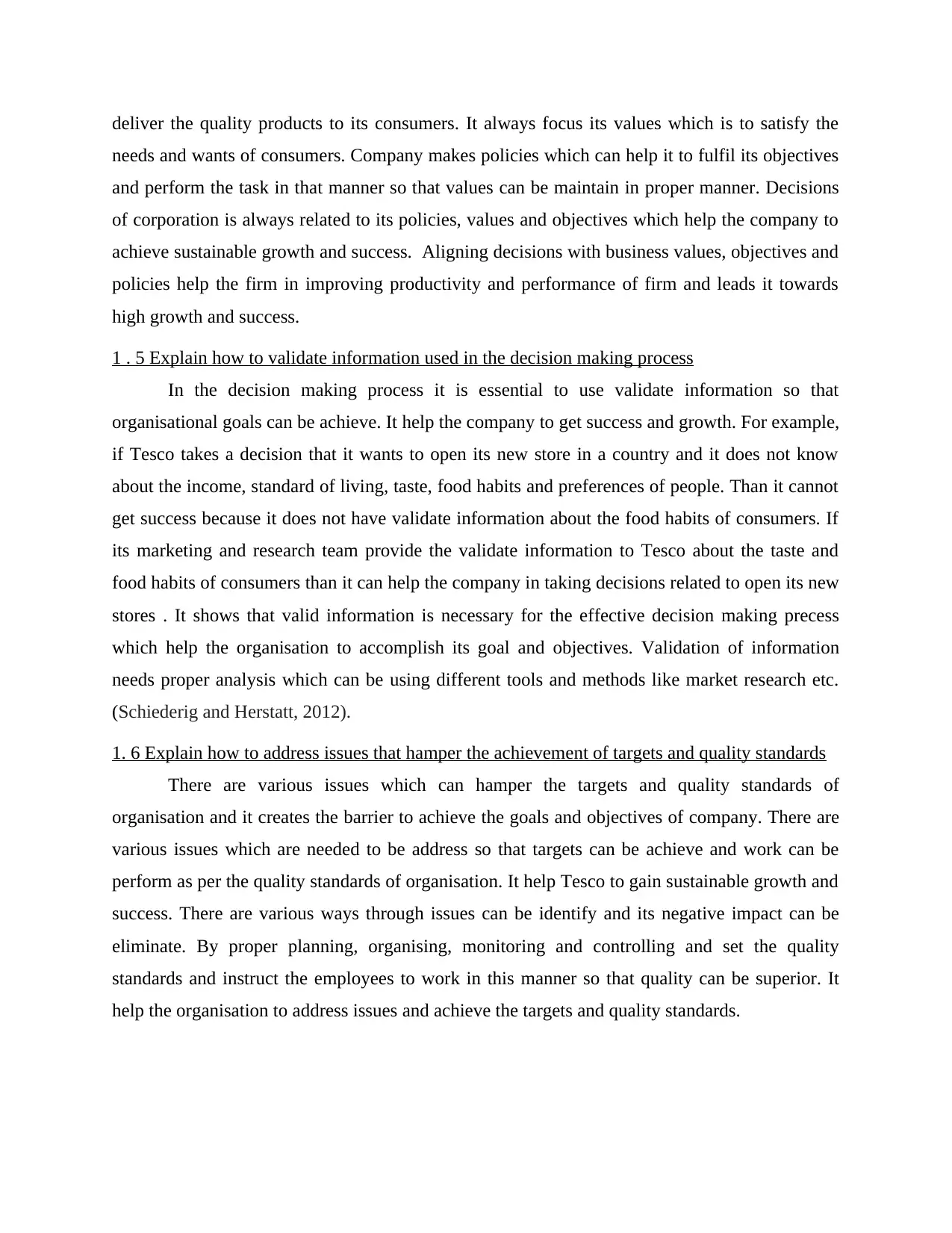
deliver the quality products to its consumers. It always focus its values which is to satisfy the
needs and wants of consumers. Company makes policies which can help it to fulfil its objectives
and perform the task in that manner so that values can be maintain in proper manner. Decisions
of corporation is always related to its policies, values and objectives which help the company to
achieve sustainable growth and success. Aligning decisions with business values, objectives and
policies help the firm in improving productivity and performance of firm and leads it towards
high growth and success.
1 . 5 Explain how to validate information used in the decision making process
In the decision making process it is essential to use validate information so that
organisational goals can be achieve. It help the company to get success and growth. For example,
if Tesco takes a decision that it wants to open its new store in a country and it does not know
about the income, standard of living, taste, food habits and preferences of people. Than it cannot
get success because it does not have validate information about the food habits of consumers. If
its marketing and research team provide the validate information to Tesco about the taste and
food habits of consumers than it can help the company in taking decisions related to open its new
stores . It shows that valid information is necessary for the effective decision making precess
which help the organisation to accomplish its goal and objectives. Validation of information
needs proper analysis which can be using different tools and methods like market research etc.
(Schiederig and Herstatt, 2012).
1. 6 Explain how to address issues that hamper the achievement of targets and quality standards
There are various issues which can hamper the targets and quality standards of
organisation and it creates the barrier to achieve the goals and objectives of company. There are
various issues which are needed to be address so that targets can be achieve and work can be
perform as per the quality standards of organisation. It help Tesco to gain sustainable growth and
success. There are various ways through issues can be identify and its negative impact can be
eliminate. By proper planning, organising, monitoring and controlling and set the quality
standards and instruct the employees to work in this manner so that quality can be superior. It
help the organisation to address issues and achieve the targets and quality standards.
needs and wants of consumers. Company makes policies which can help it to fulfil its objectives
and perform the task in that manner so that values can be maintain in proper manner. Decisions
of corporation is always related to its policies, values and objectives which help the company to
achieve sustainable growth and success. Aligning decisions with business values, objectives and
policies help the firm in improving productivity and performance of firm and leads it towards
high growth and success.
1 . 5 Explain how to validate information used in the decision making process
In the decision making process it is essential to use validate information so that
organisational goals can be achieve. It help the company to get success and growth. For example,
if Tesco takes a decision that it wants to open its new store in a country and it does not know
about the income, standard of living, taste, food habits and preferences of people. Than it cannot
get success because it does not have validate information about the food habits of consumers. If
its marketing and research team provide the validate information to Tesco about the taste and
food habits of consumers than it can help the company in taking decisions related to open its new
stores . It shows that valid information is necessary for the effective decision making precess
which help the organisation to accomplish its goal and objectives. Validation of information
needs proper analysis which can be using different tools and methods like market research etc.
(Schiederig and Herstatt, 2012).
1. 6 Explain how to address issues that hamper the achievement of targets and quality standards
There are various issues which can hamper the targets and quality standards of
organisation and it creates the barrier to achieve the goals and objectives of company. There are
various issues which are needed to be address so that targets can be achieve and work can be
perform as per the quality standards of organisation. It help Tesco to gain sustainable growth and
success. There are various ways through issues can be identify and its negative impact can be
eliminate. By proper planning, organising, monitoring and controlling and set the quality
standards and instruct the employees to work in this manner so that quality can be superior. It
help the organisation to address issues and achieve the targets and quality standards.
⊘ This is a preview!⊘
Do you want full access?
Subscribe today to unlock all pages.

Trusted by 1+ million students worldwide
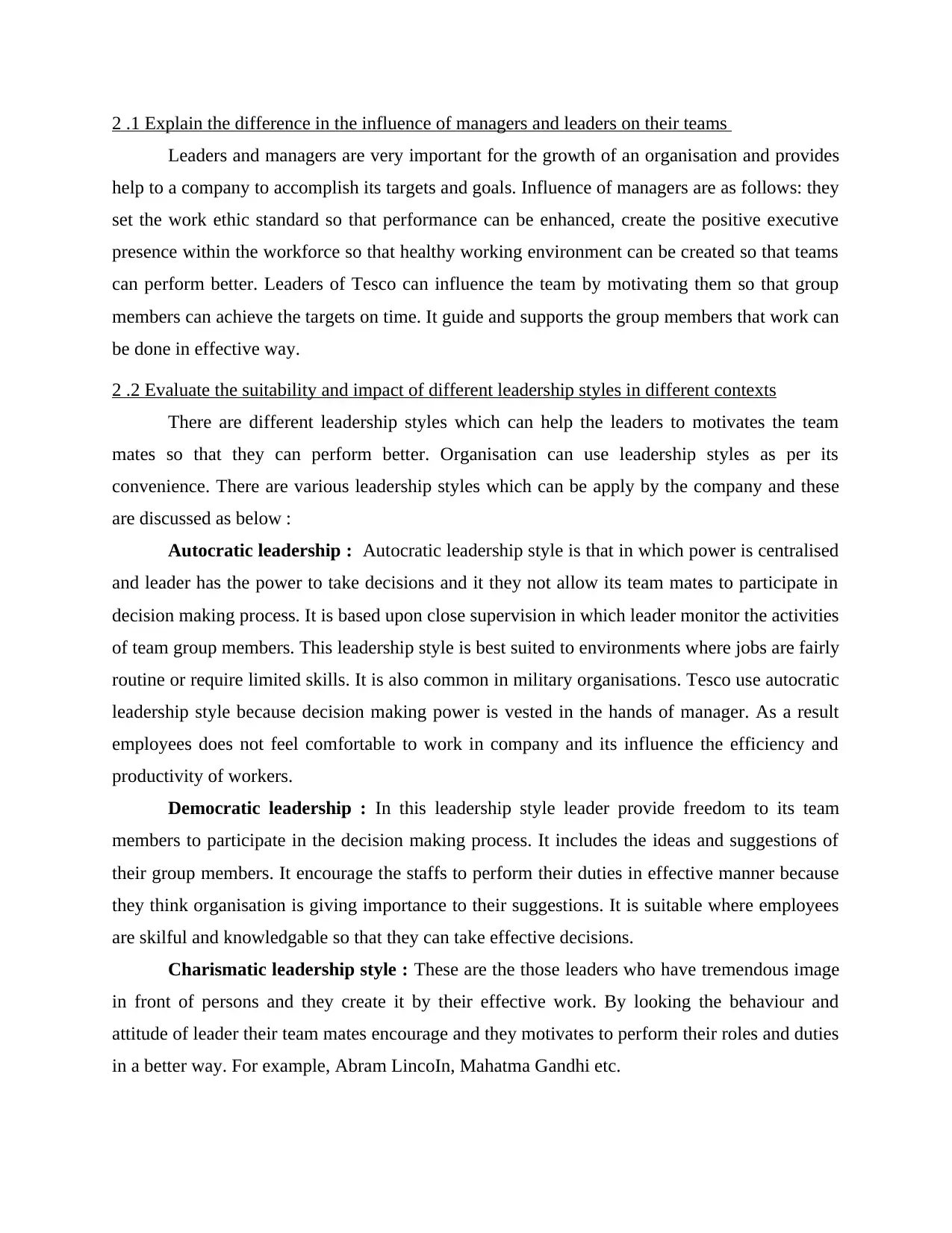
2 .1 Explain the difference in the influence of managers and leaders on their teams
Leaders and managers are very important for the growth of an organisation and provides
help to a company to accomplish its targets and goals. Influence of managers are as follows: they
set the work ethic standard so that performance can be enhanced, create the positive executive
presence within the workforce so that healthy working environment can be created so that teams
can perform better. Leaders of Tesco can influence the team by motivating them so that group
members can achieve the targets on time. It guide and supports the group members that work can
be done in effective way.
2 .2 Evaluate the suitability and impact of different leadership styles in different contexts
There are different leadership styles which can help the leaders to motivates the team
mates so that they can perform better. Organisation can use leadership styles as per its
convenience. There are various leadership styles which can be apply by the company and these
are discussed as below :
Autocratic leadership : Autocratic leadership style is that in which power is centralised
and leader has the power to take decisions and it they not allow its team mates to participate in
decision making process. It is based upon close supervision in which leader monitor the activities
of team group members. This leadership style is best suited to environments where jobs are fairly
routine or require limited skills. It is also common in military organisations. Tesco use autocratic
leadership style because decision making power is vested in the hands of manager. As a result
employees does not feel comfortable to work in company and its influence the efficiency and
productivity of workers.
Democratic leadership : In this leadership style leader provide freedom to its team
members to participate in the decision making process. It includes the ideas and suggestions of
their group members. It encourage the staffs to perform their duties in effective manner because
they think organisation is giving importance to their suggestions. It is suitable where employees
are skilful and knowledgable so that they can take effective decisions.
Charismatic leadership style : These are the those leaders who have tremendous image
in front of persons and they create it by their effective work. By looking the behaviour and
attitude of leader their team mates encourage and they motivates to perform their roles and duties
in a better way. For example, Abram LincoIn, Mahatma Gandhi etc.
Leaders and managers are very important for the growth of an organisation and provides
help to a company to accomplish its targets and goals. Influence of managers are as follows: they
set the work ethic standard so that performance can be enhanced, create the positive executive
presence within the workforce so that healthy working environment can be created so that teams
can perform better. Leaders of Tesco can influence the team by motivating them so that group
members can achieve the targets on time. It guide and supports the group members that work can
be done in effective way.
2 .2 Evaluate the suitability and impact of different leadership styles in different contexts
There are different leadership styles which can help the leaders to motivates the team
mates so that they can perform better. Organisation can use leadership styles as per its
convenience. There are various leadership styles which can be apply by the company and these
are discussed as below :
Autocratic leadership : Autocratic leadership style is that in which power is centralised
and leader has the power to take decisions and it they not allow its team mates to participate in
decision making process. It is based upon close supervision in which leader monitor the activities
of team group members. This leadership style is best suited to environments where jobs are fairly
routine or require limited skills. It is also common in military organisations. Tesco use autocratic
leadership style because decision making power is vested in the hands of manager. As a result
employees does not feel comfortable to work in company and its influence the efficiency and
productivity of workers.
Democratic leadership : In this leadership style leader provide freedom to its team
members to participate in the decision making process. It includes the ideas and suggestions of
their group members. It encourage the staffs to perform their duties in effective manner because
they think organisation is giving importance to their suggestions. It is suitable where employees
are skilful and knowledgable so that they can take effective decisions.
Charismatic leadership style : These are the those leaders who have tremendous image
in front of persons and they create it by their effective work. By looking the behaviour and
attitude of leader their team mates encourage and they motivates to perform their roles and duties
in a better way. For example, Abram LincoIn, Mahatma Gandhi etc.
Paraphrase This Document
Need a fresh take? Get an instant paraphrase of this document with our AI Paraphraser
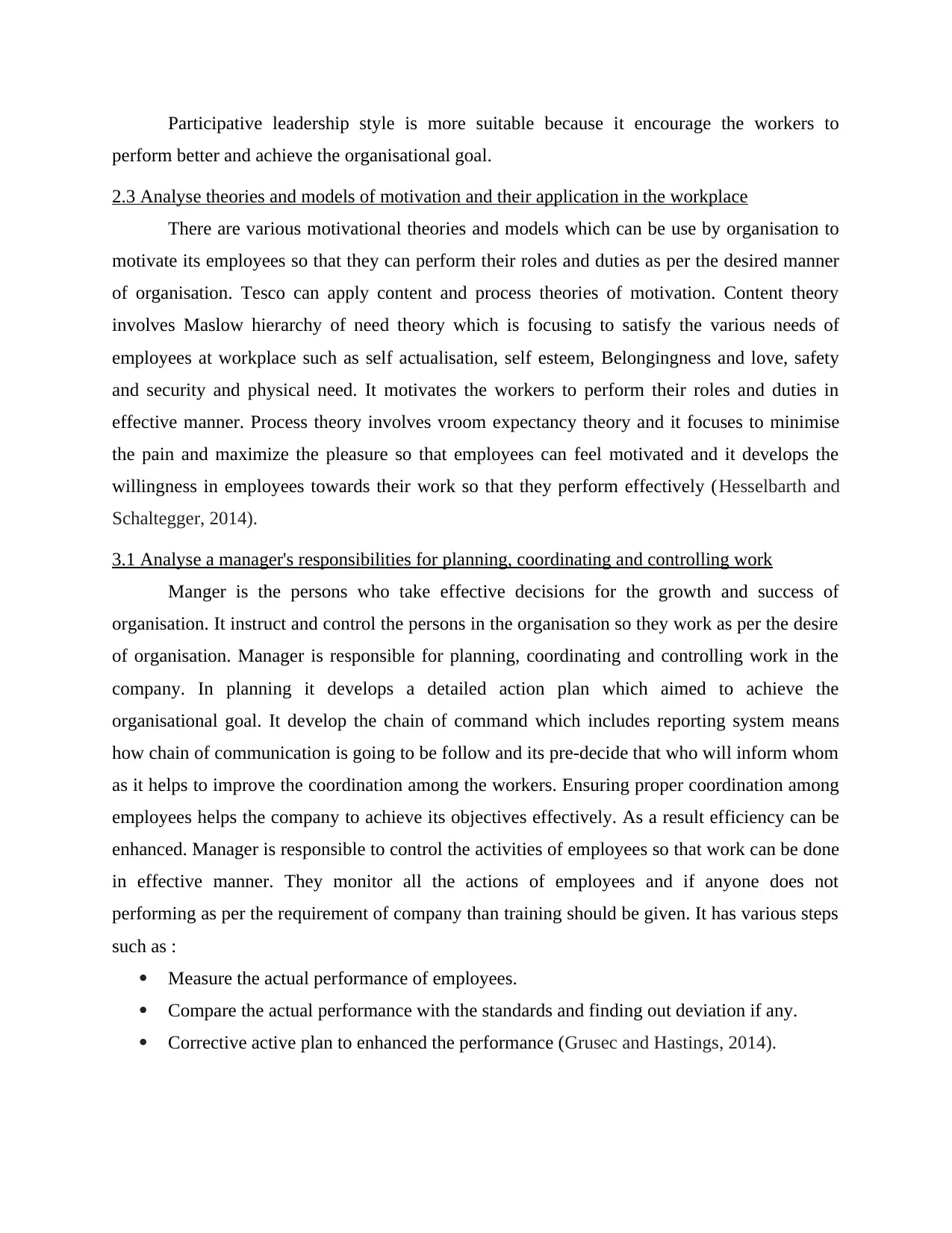
Participative leadership style is more suitable because it encourage the workers to
perform better and achieve the organisational goal.
2.3 Analyse theories and models of motivation and their application in the workplace
There are various motivational theories and models which can be use by organisation to
motivate its employees so that they can perform their roles and duties as per the desired manner
of organisation. Tesco can apply content and process theories of motivation. Content theory
involves Maslow hierarchy of need theory which is focusing to satisfy the various needs of
employees at workplace such as self actualisation, self esteem, Belongingness and love, safety
and security and physical need. It motivates the workers to perform their roles and duties in
effective manner. Process theory involves vroom expectancy theory and it focuses to minimise
the pain and maximize the pleasure so that employees can feel motivated and it develops the
willingness in employees towards their work so that they perform effectively (Hesselbarth and
Schaltegger, 2014).
3.1 Analyse a manager's responsibilities for planning, coordinating and controlling work
Manger is the persons who take effective decisions for the growth and success of
organisation. It instruct and control the persons in the organisation so they work as per the desire
of organisation. Manager is responsible for planning, coordinating and controlling work in the
company. In planning it develops a detailed action plan which aimed to achieve the
organisational goal. It develop the chain of command which includes reporting system means
how chain of communication is going to be follow and its pre-decide that who will inform whom
as it helps to improve the coordination among the workers. Ensuring proper coordination among
employees helps the company to achieve its objectives effectively. As a result efficiency can be
enhanced. Manager is responsible to control the activities of employees so that work can be done
in effective manner. They monitor all the actions of employees and if anyone does not
performing as per the requirement of company than training should be given. It has various steps
such as :
Measure the actual performance of employees.
Compare the actual performance with the standards and finding out deviation if any.
Corrective active plan to enhanced the performance (Grusec and Hastings, 2014).
perform better and achieve the organisational goal.
2.3 Analyse theories and models of motivation and their application in the workplace
There are various motivational theories and models which can be use by organisation to
motivate its employees so that they can perform their roles and duties as per the desired manner
of organisation. Tesco can apply content and process theories of motivation. Content theory
involves Maslow hierarchy of need theory which is focusing to satisfy the various needs of
employees at workplace such as self actualisation, self esteem, Belongingness and love, safety
and security and physical need. It motivates the workers to perform their roles and duties in
effective manner. Process theory involves vroom expectancy theory and it focuses to minimise
the pain and maximize the pleasure so that employees can feel motivated and it develops the
willingness in employees towards their work so that they perform effectively (Hesselbarth and
Schaltegger, 2014).
3.1 Analyse a manager's responsibilities for planning, coordinating and controlling work
Manger is the persons who take effective decisions for the growth and success of
organisation. It instruct and control the persons in the organisation so they work as per the desire
of organisation. Manager is responsible for planning, coordinating and controlling work in the
company. In planning it develops a detailed action plan which aimed to achieve the
organisational goal. It develop the chain of command which includes reporting system means
how chain of communication is going to be follow and its pre-decide that who will inform whom
as it helps to improve the coordination among the workers. Ensuring proper coordination among
employees helps the company to achieve its objectives effectively. As a result efficiency can be
enhanced. Manager is responsible to control the activities of employees so that work can be done
in effective manner. They monitor all the actions of employees and if anyone does not
performing as per the requirement of company than training should be given. It has various steps
such as :
Measure the actual performance of employees.
Compare the actual performance with the standards and finding out deviation if any.
Corrective active plan to enhanced the performance (Grusec and Hastings, 2014).
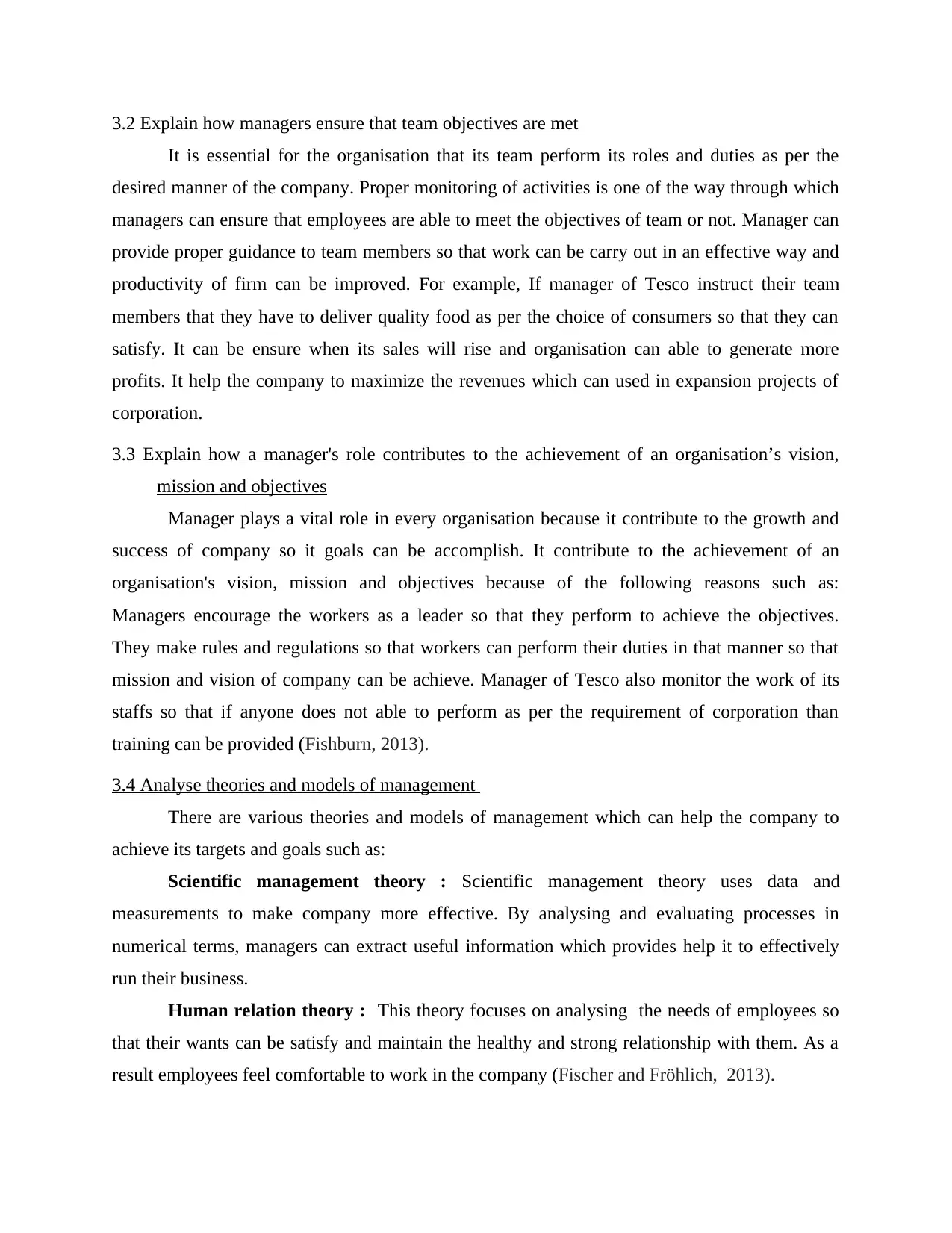
3.2 Explain how managers ensure that team objectives are met
It is essential for the organisation that its team perform its roles and duties as per the
desired manner of the company. Proper monitoring of activities is one of the way through which
managers can ensure that employees are able to meet the objectives of team or not. Manager can
provide proper guidance to team members so that work can be carry out in an effective way and
productivity of firm can be improved. For example, If manager of Tesco instruct their team
members that they have to deliver quality food as per the choice of consumers so that they can
satisfy. It can be ensure when its sales will rise and organisation can able to generate more
profits. It help the company to maximize the revenues which can used in expansion projects of
corporation.
3.3 Explain how a manager's role contributes to the achievement of an organisation’s vision,
mission and objectives
Manager plays a vital role in every organisation because it contribute to the growth and
success of company so it goals can be accomplish. It contribute to the achievement of an
organisation's vision, mission and objectives because of the following reasons such as:
Managers encourage the workers as a leader so that they perform to achieve the objectives.
They make rules and regulations so that workers can perform their duties in that manner so that
mission and vision of company can be achieve. Manager of Tesco also monitor the work of its
staffs so that if anyone does not able to perform as per the requirement of corporation than
training can be provided (Fishburn, 2013).
3.4 Analyse theories and models of management
There are various theories and models of management which can help the company to
achieve its targets and goals such as:
Scientific management theory : Scientific management theory uses data and
measurements to make company more effective. By analysing and evaluating processes in
numerical terms, managers can extract useful information which provides help it to effectively
run their business.
Human relation theory : This theory focuses on analysing the needs of employees so
that their wants can be satisfy and maintain the healthy and strong relationship with them. As a
result employees feel comfortable to work in the company (Fischer and Fröhlich, 2013).
It is essential for the organisation that its team perform its roles and duties as per the
desired manner of the company. Proper monitoring of activities is one of the way through which
managers can ensure that employees are able to meet the objectives of team or not. Manager can
provide proper guidance to team members so that work can be carry out in an effective way and
productivity of firm can be improved. For example, If manager of Tesco instruct their team
members that they have to deliver quality food as per the choice of consumers so that they can
satisfy. It can be ensure when its sales will rise and organisation can able to generate more
profits. It help the company to maximize the revenues which can used in expansion projects of
corporation.
3.3 Explain how a manager's role contributes to the achievement of an organisation’s vision,
mission and objectives
Manager plays a vital role in every organisation because it contribute to the growth and
success of company so it goals can be accomplish. It contribute to the achievement of an
organisation's vision, mission and objectives because of the following reasons such as:
Managers encourage the workers as a leader so that they perform to achieve the objectives.
They make rules and regulations so that workers can perform their duties in that manner so that
mission and vision of company can be achieve. Manager of Tesco also monitor the work of its
staffs so that if anyone does not able to perform as per the requirement of corporation than
training can be provided (Fishburn, 2013).
3.4 Analyse theories and models of management
There are various theories and models of management which can help the company to
achieve its targets and goals such as:
Scientific management theory : Scientific management theory uses data and
measurements to make company more effective. By analysing and evaluating processes in
numerical terms, managers can extract useful information which provides help it to effectively
run their business.
Human relation theory : This theory focuses on analysing the needs of employees so
that their wants can be satisfy and maintain the healthy and strong relationship with them. As a
result employees feel comfortable to work in the company (Fischer and Fröhlich, 2013).
⊘ This is a preview!⊘
Do you want full access?
Subscribe today to unlock all pages.

Trusted by 1+ million students worldwide
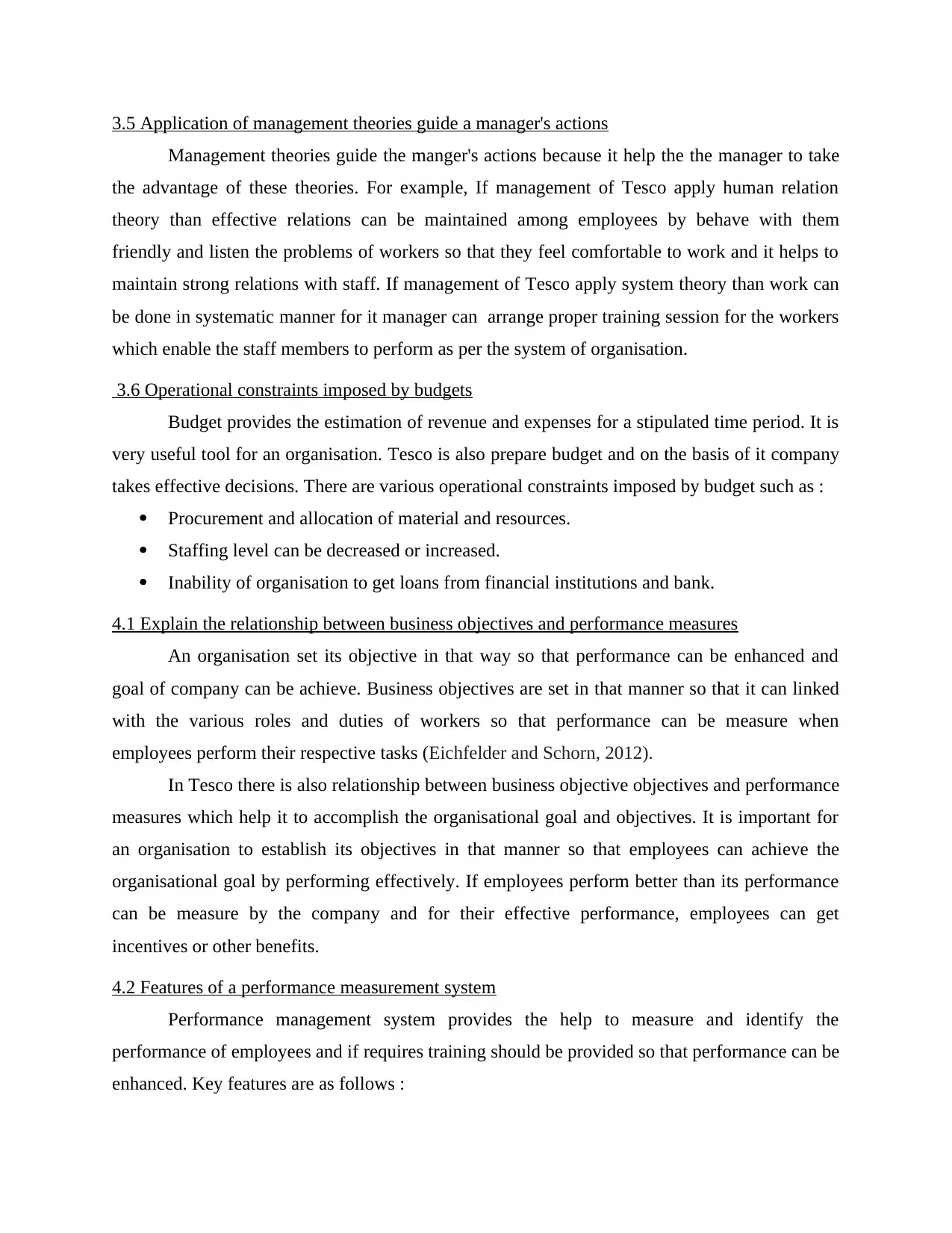
3.5 Application of management theories guide a manager's actions
Management theories guide the manger's actions because it help the the manager to take
the advantage of these theories. For example, If management of Tesco apply human relation
theory than effective relations can be maintained among employees by behave with them
friendly and listen the problems of workers so that they feel comfortable to work and it helps to
maintain strong relations with staff. If management of Tesco apply system theory than work can
be done in systematic manner for it manager can arrange proper training session for the workers
which enable the staff members to perform as per the system of organisation.
3.6 Operational constraints imposed by budgets
Budget provides the estimation of revenue and expenses for a stipulated time period. It is
very useful tool for an organisation. Tesco is also prepare budget and on the basis of it company
takes effective decisions. There are various operational constraints imposed by budget such as :
Procurement and allocation of material and resources.
Staffing level can be decreased or increased.
Inability of organisation to get loans from financial institutions and bank.
4.1 Explain the relationship between business objectives and performance measures
An organisation set its objective in that way so that performance can be enhanced and
goal of company can be achieve. Business objectives are set in that manner so that it can linked
with the various roles and duties of workers so that performance can be measure when
employees perform their respective tasks (Eichfelder and Schorn, 2012).
In Tesco there is also relationship between business objective objectives and performance
measures which help it to accomplish the organisational goal and objectives. It is important for
an organisation to establish its objectives in that manner so that employees can achieve the
organisational goal by performing effectively. If employees perform better than its performance
can be measure by the company and for their effective performance, employees can get
incentives or other benefits.
4.2 Features of a performance measurement system
Performance management system provides the help to measure and identify the
performance of employees and if requires training should be provided so that performance can be
enhanced. Key features are as follows :
Management theories guide the manger's actions because it help the the manager to take
the advantage of these theories. For example, If management of Tesco apply human relation
theory than effective relations can be maintained among employees by behave with them
friendly and listen the problems of workers so that they feel comfortable to work and it helps to
maintain strong relations with staff. If management of Tesco apply system theory than work can
be done in systematic manner for it manager can arrange proper training session for the workers
which enable the staff members to perform as per the system of organisation.
3.6 Operational constraints imposed by budgets
Budget provides the estimation of revenue and expenses for a stipulated time period. It is
very useful tool for an organisation. Tesco is also prepare budget and on the basis of it company
takes effective decisions. There are various operational constraints imposed by budget such as :
Procurement and allocation of material and resources.
Staffing level can be decreased or increased.
Inability of organisation to get loans from financial institutions and bank.
4.1 Explain the relationship between business objectives and performance measures
An organisation set its objective in that way so that performance can be enhanced and
goal of company can be achieve. Business objectives are set in that manner so that it can linked
with the various roles and duties of workers so that performance can be measure when
employees perform their respective tasks (Eichfelder and Schorn, 2012).
In Tesco there is also relationship between business objective objectives and performance
measures which help it to accomplish the organisational goal and objectives. It is important for
an organisation to establish its objectives in that manner so that employees can achieve the
organisational goal by performing effectively. If employees perform better than its performance
can be measure by the company and for their effective performance, employees can get
incentives or other benefits.
4.2 Features of a performance measurement system
Performance management system provides the help to measure and identify the
performance of employees and if requires training should be provided so that performance can be
enhanced. Key features are as follows :
Paraphrase This Document
Need a fresh take? Get an instant paraphrase of this document with our AI Paraphraser
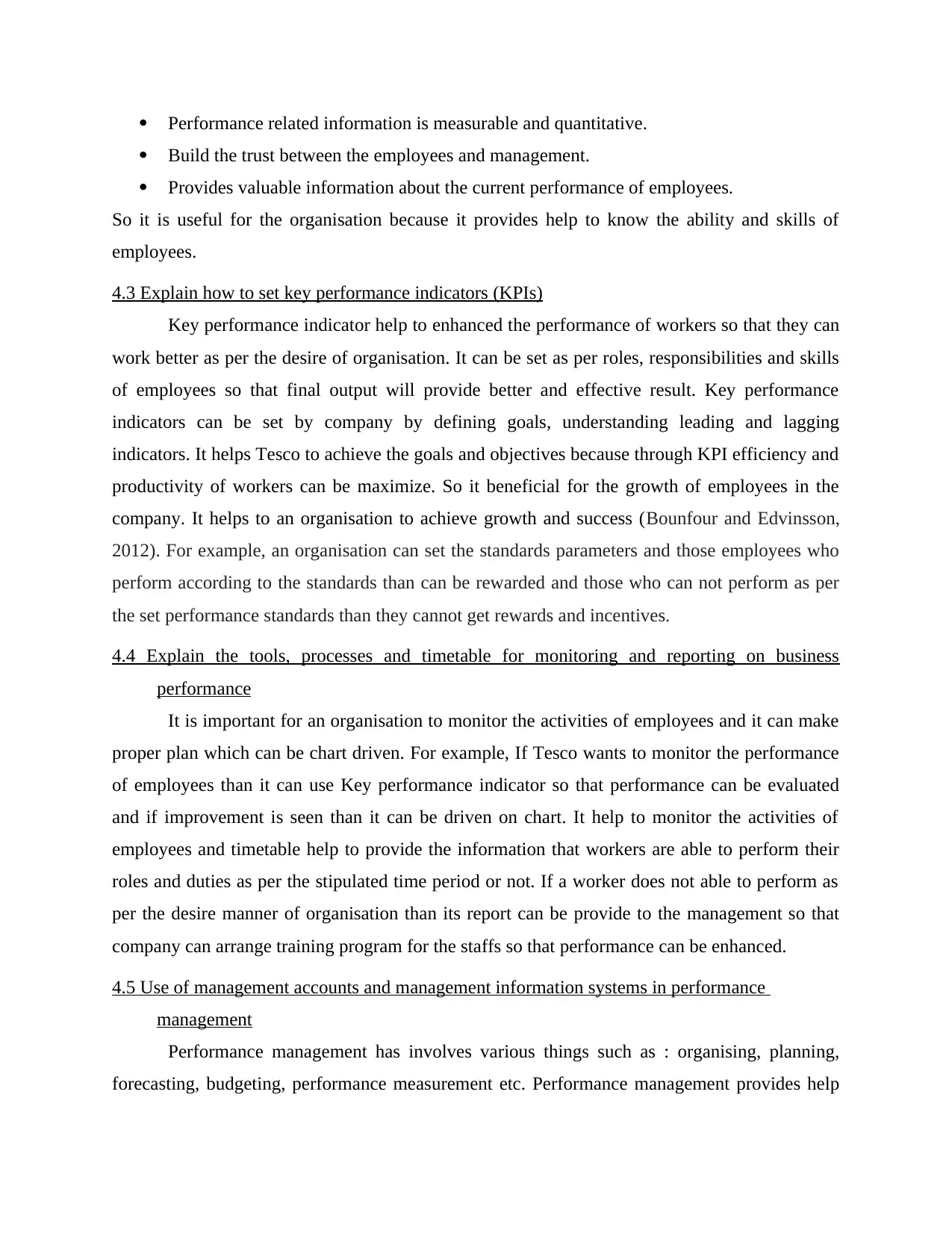
Performance related information is measurable and quantitative.
Build the trust between the employees and management.
Provides valuable information about the current performance of employees.
So it is useful for the organisation because it provides help to know the ability and skills of
employees.
4.3 Explain how to set key performance indicators (KPIs)
Key performance indicator help to enhanced the performance of workers so that they can
work better as per the desire of organisation. It can be set as per roles, responsibilities and skills
of employees so that final output will provide better and effective result. Key performance
indicators can be set by company by defining goals, understanding leading and lagging
indicators. It helps Tesco to achieve the goals and objectives because through KPI efficiency and
productivity of workers can be maximize. So it beneficial for the growth of employees in the
company. It helps to an organisation to achieve growth and success (Bounfour and Edvinsson,
2012). For example, an organisation can set the standards parameters and those employees who
perform according to the standards than can be rewarded and those who can not perform as per
the set performance standards than they cannot get rewards and incentives.
4.4 Explain the tools, processes and timetable for monitoring and reporting on business
performance
It is important for an organisation to monitor the activities of employees and it can make
proper plan which can be chart driven. For example, If Tesco wants to monitor the performance
of employees than it can use Key performance indicator so that performance can be evaluated
and if improvement is seen than it can be driven on chart. It help to monitor the activities of
employees and timetable help to provide the information that workers are able to perform their
roles and duties as per the stipulated time period or not. If a worker does not able to perform as
per the desire manner of organisation than its report can be provide to the management so that
company can arrange training program for the staffs so that performance can be enhanced.
4.5 Use of management accounts and management information systems in performance
management
Performance management has involves various things such as : organising, planning,
forecasting, budgeting, performance measurement etc. Performance management provides help
Build the trust between the employees and management.
Provides valuable information about the current performance of employees.
So it is useful for the organisation because it provides help to know the ability and skills of
employees.
4.3 Explain how to set key performance indicators (KPIs)
Key performance indicator help to enhanced the performance of workers so that they can
work better as per the desire of organisation. It can be set as per roles, responsibilities and skills
of employees so that final output will provide better and effective result. Key performance
indicators can be set by company by defining goals, understanding leading and lagging
indicators. It helps Tesco to achieve the goals and objectives because through KPI efficiency and
productivity of workers can be maximize. So it beneficial for the growth of employees in the
company. It helps to an organisation to achieve growth and success (Bounfour and Edvinsson,
2012). For example, an organisation can set the standards parameters and those employees who
perform according to the standards than can be rewarded and those who can not perform as per
the set performance standards than they cannot get rewards and incentives.
4.4 Explain the tools, processes and timetable for monitoring and reporting on business
performance
It is important for an organisation to monitor the activities of employees and it can make
proper plan which can be chart driven. For example, If Tesco wants to monitor the performance
of employees than it can use Key performance indicator so that performance can be evaluated
and if improvement is seen than it can be driven on chart. It help to monitor the activities of
employees and timetable help to provide the information that workers are able to perform their
roles and duties as per the stipulated time period or not. If a worker does not able to perform as
per the desire manner of organisation than its report can be provide to the management so that
company can arrange training program for the staffs so that performance can be enhanced.
4.5 Use of management accounts and management information systems in performance
management
Performance management has involves various things such as : organising, planning,
forecasting, budgeting, performance measurement etc. Performance management provides help
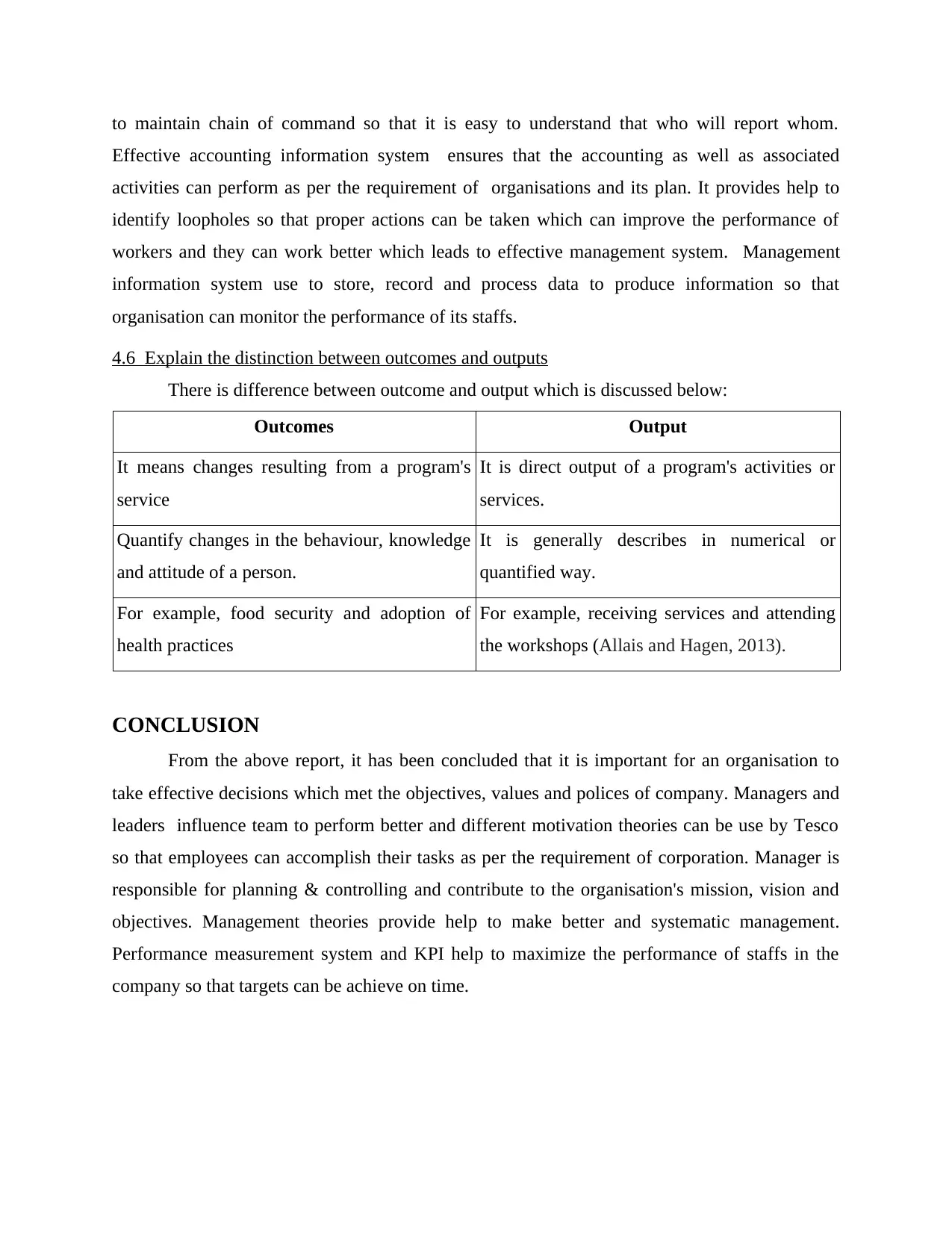
to maintain chain of command so that it is easy to understand that who will report whom.
Effective accounting information system ensures that the accounting as well as associated
activities can perform as per the requirement of organisations and its plan. It provides help to
identify loopholes so that proper actions can be taken which can improve the performance of
workers and they can work better which leads to effective management system. Management
information system use to store, record and process data to produce information so that
organisation can monitor the performance of its staffs.
4.6 Explain the distinction between outcomes and outputs
There is difference between outcome and output which is discussed below:
Outcomes Output
It means changes resulting from a program's
service
It is direct output of a program's activities or
services.
Quantify changes in the behaviour, knowledge
and attitude of a person.
It is generally describes in numerical or
quantified way.
For example, food security and adoption of
health practices
For example, receiving services and attending
the workshops (Allais and Hagen, 2013).
CONCLUSION
From the above report, it has been concluded that it is important for an organisation to
take effective decisions which met the objectives, values and polices of company. Managers and
leaders influence team to perform better and different motivation theories can be use by Tesco
so that employees can accomplish their tasks as per the requirement of corporation. Manager is
responsible for planning & controlling and contribute to the organisation's mission, vision and
objectives. Management theories provide help to make better and systematic management.
Performance measurement system and KPI help to maximize the performance of staffs in the
company so that targets can be achieve on time.
Effective accounting information system ensures that the accounting as well as associated
activities can perform as per the requirement of organisations and its plan. It provides help to
identify loopholes so that proper actions can be taken which can improve the performance of
workers and they can work better which leads to effective management system. Management
information system use to store, record and process data to produce information so that
organisation can monitor the performance of its staffs.
4.6 Explain the distinction between outcomes and outputs
There is difference between outcome and output which is discussed below:
Outcomes Output
It means changes resulting from a program's
service
It is direct output of a program's activities or
services.
Quantify changes in the behaviour, knowledge
and attitude of a person.
It is generally describes in numerical or
quantified way.
For example, food security and adoption of
health practices
For example, receiving services and attending
the workshops (Allais and Hagen, 2013).
CONCLUSION
From the above report, it has been concluded that it is important for an organisation to
take effective decisions which met the objectives, values and polices of company. Managers and
leaders influence team to perform better and different motivation theories can be use by Tesco
so that employees can accomplish their tasks as per the requirement of corporation. Manager is
responsible for planning & controlling and contribute to the organisation's mission, vision and
objectives. Management theories provide help to make better and systematic management.
Performance measurement system and KPI help to maximize the performance of staffs in the
company so that targets can be achieve on time.
⊘ This is a preview!⊘
Do you want full access?
Subscribe today to unlock all pages.

Trusted by 1+ million students worldwide
1 out of 13
Related Documents
Your All-in-One AI-Powered Toolkit for Academic Success.
+13062052269
info@desklib.com
Available 24*7 on WhatsApp / Email
![[object Object]](/_next/static/media/star-bottom.7253800d.svg)
Unlock your academic potential
Copyright © 2020–2025 A2Z Services. All Rights Reserved. Developed and managed by ZUCOL.




